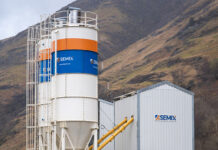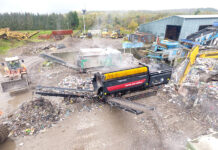As efforts to combat climate change intensify, an emphasis on tackling the impact of waste on our environment has become a crucial factor. Here, Matthew Bastable of BPH Attachments discusses the importance of improving reuse and recycling rates in construction
THE construction industry is under increasing pressure to reduce waste. According to a report by The Waste and Resources Action Programme (WRAP), the sector uses 400 million tonnes of material every year, resulting in 100 million tonnes of waste. This accounts for a staggering third of the UK’s total yearly waste with a massive 25 million tonnes of construction waste ending up in landfill.
Generating site waste is often unavoidable but construction companies still have a legal obligation to ensure it is properly managed and that waste is reused or recycled wherever possible through a Site Waste Management Plan (SWMP). Sending waste to landfill should only be a last resort. However, 13% of products delivered to construction sites are sent directly to landfill without having been used. This has not only huge implications for the environment, but a large effect on a company’s bottom line.
By using materials in a better way, and reducing, reusing and sorting waste for recycling, construction companies could save thousands of pounds per project and greatly minimise the impact they have on the environment.
Managing waste on construction sites can be a complicated and time-consuming business. But, through careful planning, it is possible to eliminate waste and identify materials that can be reused and recycled.
Having a clear understanding of the project and choosing materials wisely from the outset will help to encourage more effective waste disposal planning.
Common types of construction waste include:
• Concrete, bricks, tiles, cement and ceramics
• Wood, glass and plastic
• Insulation materials, including asbestos
• Bituminous mixtures, coal tar, and tar
• Metallic waste, such as pipes
Soil, stones, and dredging
• Paints and varnishes
• Sealants and adhesives
Sorting waste for reuse and recycling
While understanding which materials can be successfully reused and recycled is pivotal to reducing waste going to landfill, this also relies on the processes adopted to recover it and prevent it from ending up in landfill unintentionally.
Materials should always be screened before being sent to landfill. Specialist machinery, such as BPH Attachment’s PRODEM Rotary screening bucket, is designed to sort site material quickly and easily for reuse. Materials, including aggregates, organic waste, and covering pipes, can all be sorted with an attachment that fits to machinery already on site, such as excavators and wheel loaders, helping to save time and money and improve a project’s waste ratio.
Construction companies are finding these attachments are offering numerous benefits for projects. For example, bricks, blocks and concrete can be easily sorted and reused on other projects for creating new roads and pathways. This saves money, improves overall environmental performance and ensures legal obligations are met.
The estimated cost of waste to a construction project is approximately ten times that of a single skip hire. Additionally, landfill tax, disposal charges and the cost of materials are all set to substantially rise in the coming years.
Waste will continue to be a problem for the construction industry so finding innovative methods for managing it successfully is not only essential for business efficiency, but an ethical responsibility for future generations.













